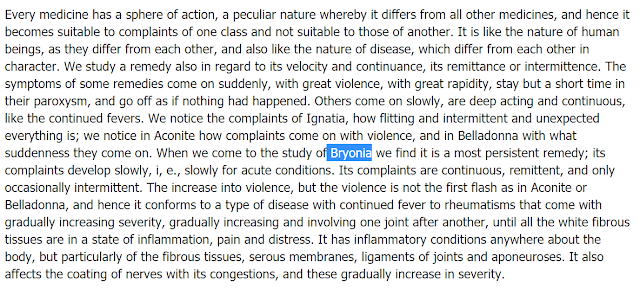1 How NOT to Read Materia Medica.
Most nonfiction books are written in the same manner and we are well adapted to read them as such: the author introduces his Big Idea in a paragraph or even in one sentence. Then writes few paragraphs to support his Big Idea. And in conclusion, gives a summary of the Idea and why it should be accepted. That basically leads us to the habit of reading carefully an Intro - a few first sentences at the beginning and a Summary - few last sentences. Information in the middle we scan just to complete the mental picture formed by reading the introductory sentences and the summary sentences.
We could probably read Kent Lectures on Materia Medica like that. If they were broken down into paragraphs: (examples below).
We surely could not read Hering's Guiding Symptoms or Hering's Condensed Materia Medica like this, because every line in what we can roughly call a paragraph or a section is devoted to an organ system or sensory perceptions, and IS important. The sentences that form these paragraphs or sections are not connected, not linked to each other by a single unifying idea. Except maybe the one that they all describe same remedy. But that usually does not help much. After a while, the brain is overwhelmed with utter hopelessness to find any pattern, anything on basis of which all these sentences can be united and committed to memory.
Imagine you see in front of you a pile of identical wooden dowels.
Yes, after a careful examination you see how one is different from another, but these differences are not very memorable. You have to constantly make a mental inventory of them. Now imagine you have 48 piles of these wooden dowels - exactly the number of paragraphs in Hering's Materia Medica for each remedy - from "Mind" to "Relations") and each one looks just like another. Now multiply them by the number of remedies you need to know to practice well - about 150 by the latest CHC count. How in the world do you memorize and learn to tell apart 2400 wooden piles? Looks like Kent in his Lectures on Homeopathic Materia Medica had a solution to that dilemma.
2. Kent's "Stick Figures" and Sankaran's Heroes
Actually, it looks like Kent took Hering's bare wooden dowels, and made a stick figures out of them. Much easier to tell them apart now. Later homeopaths put some clothes on these stick figures to make them even more recognizable, and Sankaran got rid of the stick figures altogether. Sankaran gave the stick figures' clothes to real people with names and stories. He turned them into heroes that are hard to forget. Unmemorizable and unmemorized wooden dowels are happily casted off to the side. Several years and number of failed cases later a student of homeopathy will be going back to look for piles of wooden dowels to see if they can help in clinical practice. After Materia Medica's of later years that read like a novel, it takes a lot of mental grit to open back our dear classics, to start packing Kent's long paragraphs into pre-set ideas about a remedy accumulated over the years of classes and seminars and finding any memorable connections among Hering's guiding symptoms. But if you are just starting with learning homeopathy, and if you can't devote eight hours a day to reading Materia Medica of the old masters, there is nothing wrong with asking yourself: What do I really want to get out my studies? What is my learning style? How do I process the information? Fancy labels aside, people are divided into
- those who can consume large quantities of information and break it up in understandable and memorable, usable knowledge, and
- those who needs to see how the information was collected to be able to assemble the big picture for themselves.
3. Tools that Help to Make Sense Out of Any Old Materia Medica
Buckle up, clear some desk space. Anything not directly related to what you will be doing should not be in your field of view.
The following exercise can be done "virtually" or as a mental exercise but I recommend to roll up your sleeves, and crank up your printer to actually cut and paste the text inserting headings and physically separating text into comprehensible chunks.- Introduction, with or without Sub-headings
- Paragraphs, ideally with Headings for main idea of the paragraph and Sub-headings as an overview of the paragraph's content, and finally
- Conclusion (Summary), usually without Sub-headings.
4. How To Read Materia Medica
I will be using as an example Lecture on Bryonia from Kent's Lectures (link to free text).
Here is a screenshot of the first "paragraph":So, let's eat this elephant one bite at a time. First, we see that the subject of this lecture - the Bryonia itself is mentioned for the first time in the middle of the paragraph. That gives us a clue that preceding text may very well be turned into visually-appealing Introduction.
And now let's connect both halves on the Introduction together:
Because the lecture is on Bryonia, and the only remedies mentioned in the Introduction are Aconite, Belladonna and Ignatia along with discussion about peculiarity of each remedy, we are now prepared to see how Bryonia is similar or different from the remedies mentioned. We cleared up imaginary shelf in our mind for Bryonia's specific characteristics. For more examples of breaking up old text with short explanations of each paragraph, read next post on Study of Bryonia.* I highly recommend you to refer to this article for discussion of the terms "remittance" and "intermittence":
Dall L, Stanford JF. Fever, Chills, and Night Sweats. In: Walker HK, Hall WD, Hurst JW, editors. Clinical Methods: The History, Physical, and Laboratory Examinations. 3rd edition. Boston: Butterworths; 1990. Chapter 211.
Available
from: https://www.ncbi.nlm.nih.gov/books/NBK324/







